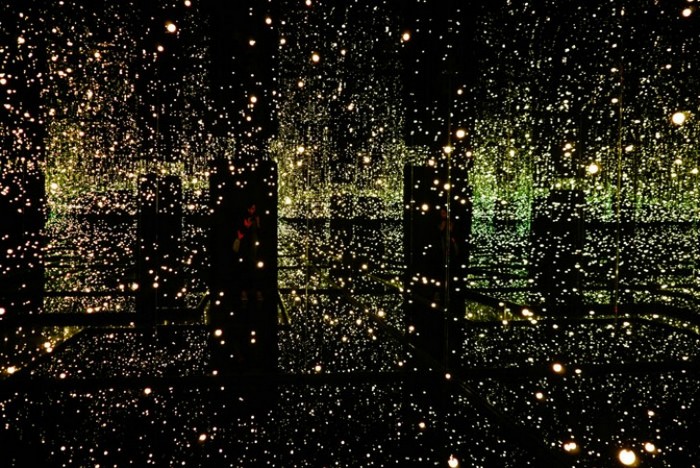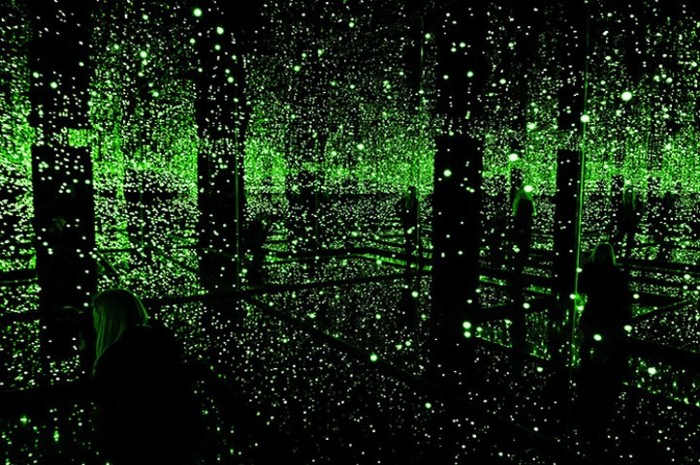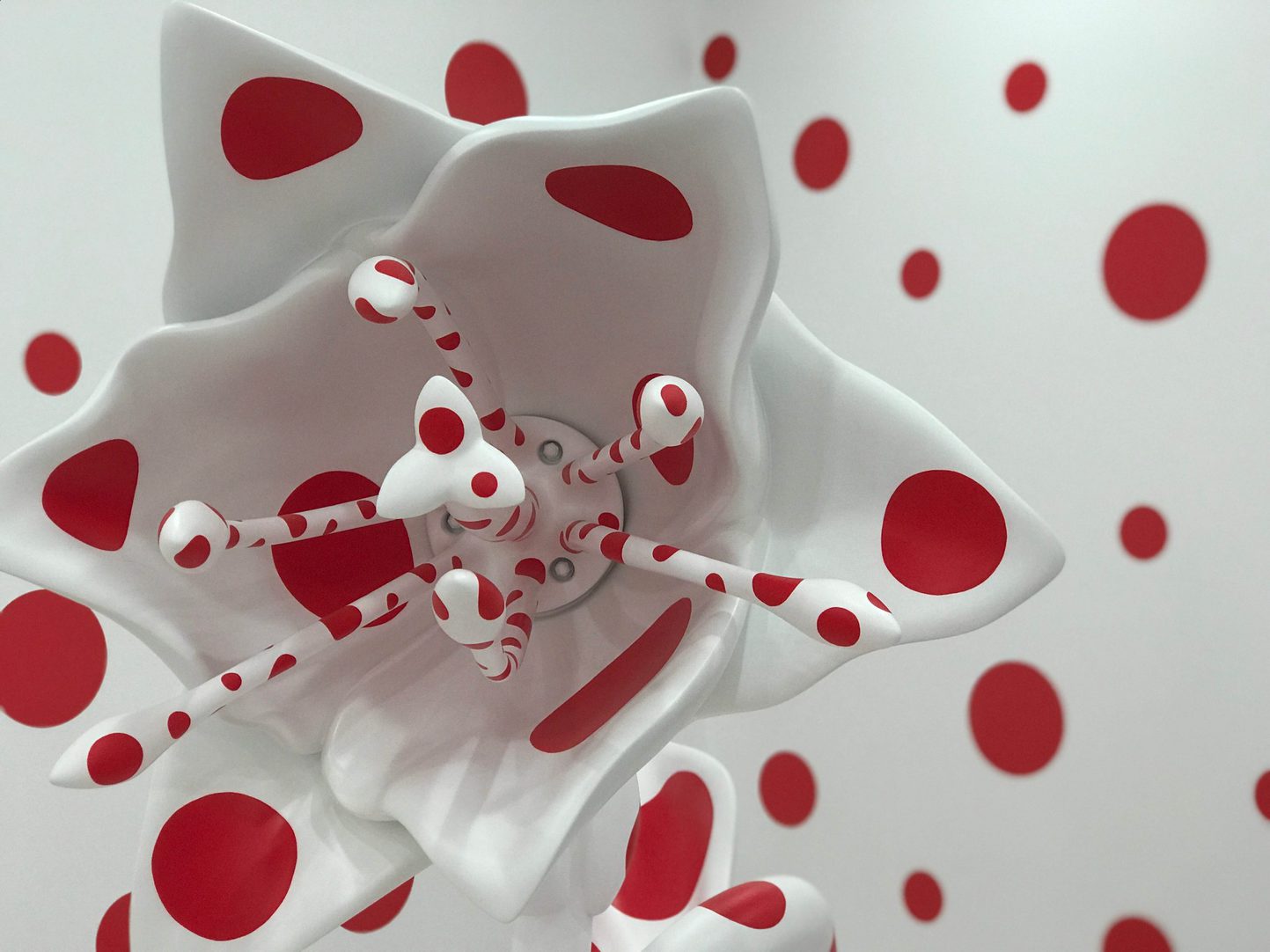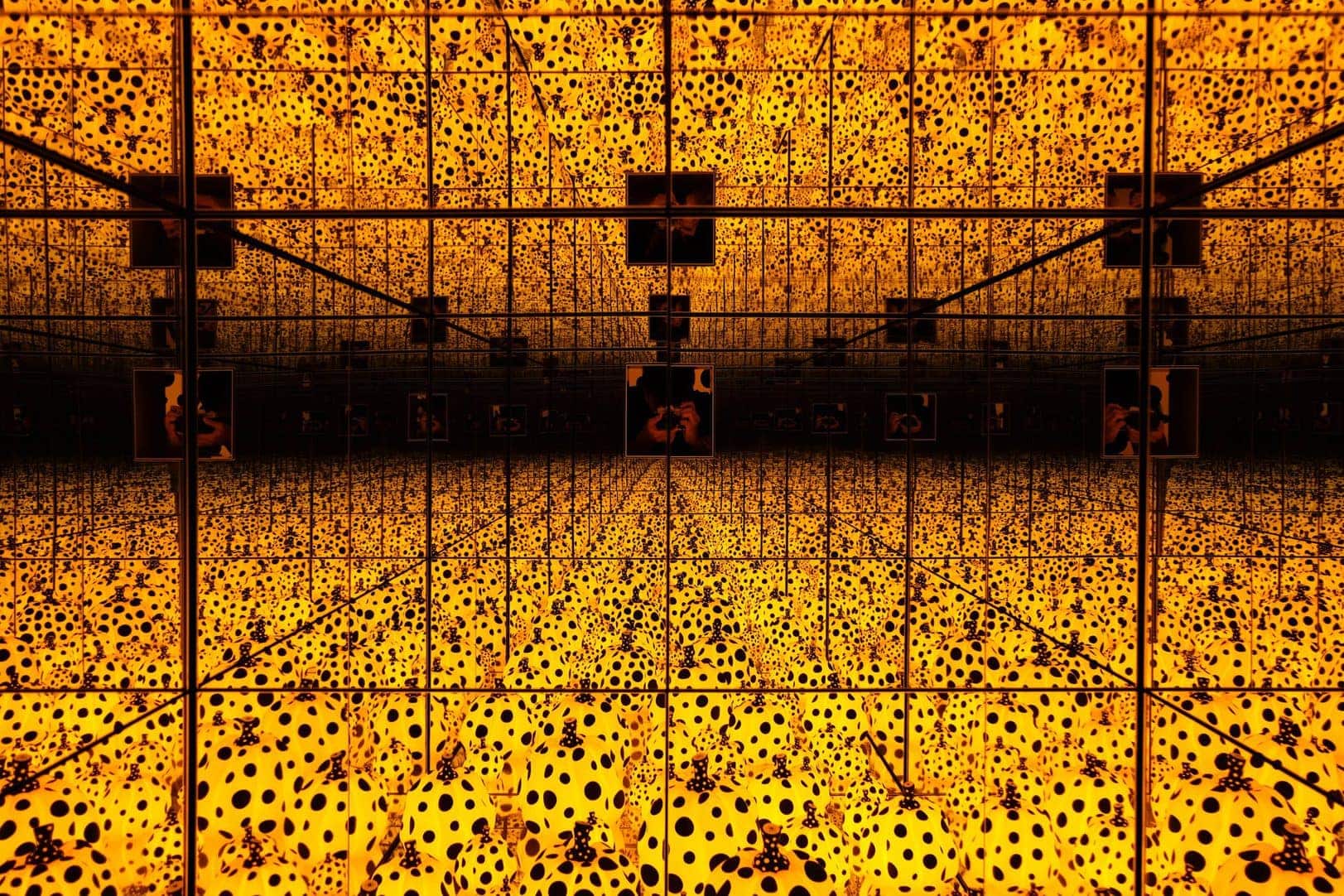- ‘My cheapo garden fairy lights do this too’ – Yayoi Kusama: Infinity Mirror Rooms
- Бесконечная зеркальная комната от Yayoi Kusama
- TEMPORARILY CLOSED—Yayoi Kusama’s Infinity Mirror Rooms
- How to See Infinity Mirrored Room—The Souls of Millions of Light Years Away
- How to see Longing for Eternity
- «Бесконечные зеркала» Яеи Кусамы вернутся в Лондон
- Yayoi Kusama Infinity Mirrors [Complete Walkthrough of Rooms]
- Background Information of Yayoi Kusama
‘My cheapo garden fairy lights do this too’ – Yayoi Kusama: Infinity Mirror Rooms
Tate Modern, London
The Japanese artist turns her visual hallucinations into a flaring and dimming clockwork universe. But I seem to be immune. Perhaps if I brought a small child or was interested in taking selfies …
A short trip . Yayoi Kusama’s Filled with the Brilliance of Life, 2011/2017. Photograph: Eduardo Ortega/Yayoi Kusama. Courtesy Ota Fine Arts and Victoria Miro
A short trip . Yayoi Kusama’s Filled with the Brilliance of Life, 2011/2017. Photograph: Eduardo Ortega/Yayoi Kusama. Courtesy Ota Fine Arts and Victoria Miro
Last modified on Mon 17 May 2021 15.54 BST
A ll done with lights and looking glasses, Yayoi Kusama’s year-long display of Infinity Mirror Rooms is already booked-out until late October. Viewers must queue and wait, at £10 a head, for two, two-minute dives into Kusama’s universe. Hardly enough time to get your bearings, let alone lose them, which seems to be the point of her disorientating halls of mirrors.
Tate Modern says it is being relatively generous about how long viewers may spend in the artist’s installations: at some venues, visitors get only 30 seconds to adjust to her glimmering darkened spaces. Then you’re out, matey, ready or not, wowed or otherwise. Time for a selfie though, if that’s your thing. And for many, I fear, it is. Although such installations are perceptually complex and disorientating, their spectacular effects are all too readily assimilable to Instagram. This really is a bit absurd. Many people are hungry, I suppose, for some kind of transformative, mystical or even transcendental experience, and one that requires neither fasting nor drugs, let alone months or years of mental and physical preparation. Inner visions, like dreams, are no good as selfie opportunities. They’re all in your head.
Kusama’s art is driven by her inner experiences, reporting back on things only the mind can see. Beset by visual hallucinations, Kusama has for almost the entirety of her long life been prey to proliferating and insistent visual disturbances. She has found ways to accommodate her fixations and subjective perceptions of unseen forces into her work, using it as source, material and energy.
Thrown rainbows … Chandelier of Grief 2016/2018. Photograph: Yayoi Kusama. Courtesy Ota Fine Arts and Victoria Miro
Walking into her Chandelier of Grief, I never quite lose my sense of planes, edges and boundaries, the black carpet under my feet, the hexagonal chamber containing a slowly revolving crystal chandelier, its lights flaring and dimming, the crystals throwing fleeting little rainbows of colour here and there. The multiple mirrored reflections seemingly revolving alternately clockwise and anticlockwise, flattening out along the horizontal plane and simultaneously plunging below us and soaring ever upward over our heads. It is as if we were in a clockwork universe of endlessly proliferating, rotating gears, a Keplerian machine of cycles and epicycles which has no end, all of which sounds a great deal more engaging than I actually found it.
In her larger, the walk-through Infinity Mirrored Room – Filled with the Brilliance of Life, little hanging lights glow and dim as they cycle through their programmed sequence of colour changes. My cheapo garden fairy lights do that too, even when I don’t want them to. As well as mirrors and a walkway, reflecting pools of water redouble the confusion. The mechanics of Kusama’s looking-glass theatres snag me, but not in particularly interesting ways. The staging of her lights and mirrors remind me less of star-fields or pinging neurons and networks of firing synapses, as of airports or refineries at night, or of being E-ed up and bathing in a disco glow, or being caught in a silent killing field of computer-game tracer fire and sci-fi force fields. None of which I plan to do any time soon. Beam me up and get me out of here before I faint from the excitement of it all.
Kusama’s Infinity Mirror Rooms just don’t do it for me. I appear to be immune to them. Maybe I’d appreciate them more if I visited with a small child, and could share in their easy wonderment, except I’d worry they might drown in one of those shallow pools. Maybe a drawn-out expectation of the moment, the booking, the waiting for the day and the minute, all that queuing, might help develop a sense of occasion.
Inner experiences … Yayoi Kusama in 2013. Photograph: Mike Segar/Reuters
Kusama’s light installations are the main event here, and are augmented by series of portrait photographs of the artist, taken over her long career, as well as pictures of performances, which are both sexy and silly, earnest and ridiculous. In a recently rediscovered short film by British academic John Jones, we see a young Kusama walking in red thigh-length boots about her studio, posing behind a stepladder festooned with little sculptures and high-heeled shoes, and lying naked from the waist down in a nest of white phallic sculptures, kapok-stuffed white gloves and other floppy forms.
As much her work looks back to surrealism, the film, shot in the mid-1960s, has both a touching innocence and an oddly prurient feel that some might take as period charm. How long you can linger to see all this, and the box-like recent sculpture whose peepholes afford colourful views of globular little dots, before the next punters are shepherded through, I cannot say.
Источник
Бесконечная зеркальная комната от Yayoi Kusama
Получайте на почту один раз в сутки одну самую читаемую статью. Присоединяйтесь к нам в Facebook и ВКонтакте.
Яей Кусама знакома постоянным читателям сайта Kulturologia.Ru благодаря своим экспериментам с визуальной составляющей жилых пространств. С помощью разноцветных точек и прочих мелких элементов она увеличивает, искривляет, растягивает комнаты. Теперь же Кусама решила поэкспериментировать с зеркалами.
В итоге появилась весьма необычная инсталляция с названием Infinity Mirror Room (Бесконечная зеркальная комната). Ведь в помещении, все стены которого от пола до потолка, от угла до угла превращены в зеркала, действительно, будет казаться, будто пространство вокруг не имеет границ. Особенно, если установить в ней ориентиры для визуальной привязки.
Вот такими ориентирами в инсталляции Infinity Mirror Room и стали разноцветные светодиоды. В условиях отсутствия верхнего освещения, эти диоды создают удивительнейшую атмосферу в комнате. Человеку, попавшему туда, кажется, будто он попал в волшебный мир, населенный миллионами огоньков, которые меняют цвет и положение. Причем, картина эта абсолютно меняется, стоит только человеку чуть изменить свое положение в пространстве или угол зрения, а светодиоду – цвет.
Понравилась статья? Тогда поддержи нас, жми:
Источник
TEMPORARILY CLOSED—Yayoi Kusama’s Infinity Mirror Rooms
Yayoi Kusama’s Infinity Mirrored Room—The Souls of Millions of Light Years Away (2013) and Longing for Eternity (2017), are closed at this time. Be the first to know when these immersive experiences will reopen—sign up for our email newsletters!
How to See Infinity Mirrored Room—The Souls of Millions of Light Years Away
Notice: This installation is a mirror-lined room with flashing LED lights that you physically enter with a door that closes behind you. If you are uncomfortable with flashing lights and/or enclosed, dark spaces, please bypass this experience.
- Obtain an admission ticket (either a free general admission ticket or a special exhibition ticket) by booking online on The Broad’s website, or by joining The Broad’s onsite standby line in the morning (the earlier, the better), and enter the museum. For the best chance to view this Infinity Mirrored Room, make your ticket reservation for a timeslot in the morning or in the very early afternoon.
- Once inside the museum, visit the iPad kiosk in the lobby to join the first-come, first-served virtual queue for The Souls of Millions of Light Years Away. You will need to enter your mobile phone number and first name. You will receive an approximate wait time.
- Enjoy the rest of the museum! You will receive a text message 10 minutes before your turn so that you have time to make your way to The Souls of Millions of Light Years Away.
- Follow the instructions included in the text message and proceed to The Souls of Millions of Light Years Away. Ask any Visitor Experience Team Member for help or directions.
- Check in with the Visitor Experience Team Member at the room and wait in a short line for your turn. Enjoy!
How to see Longing for Eternity
Notice: This installation is a mirror-lined chamber with flashing LED lights that viewers look into. If you are uncomfortable with flashing lights and/or enclosed, dark spaces, please bypass this experience.
- Longing for Eternity is located on the third floor of The Broad. Ask any Visitor Experience Team Member for directions to this artwork. Once you have arrived at Longing for Eternity, join the short line to view the artwork, or ask a Visitor Experience Team Member for help.
Источник
«Бесконечные зеркала» Яеи Кусамы вернутся в Лондон
Когда зеркальные комнаты Яеи Кусамы в 2016 году открылись в лондонской галерее Victoria Miro, посетители часами стояли в очереди, чтобы попасть внутрь. В соцсетях и СМИ горячо обсуждали Infinity Mirror Room и эффект, который выставка оказала на восприятие и сознание аудитории. Экспозиция с успехом объехала весь мир.
В октябре Infinity Mirror Room возвращается в Victoria Miro. На главной выставке будут представлены новые творения японской художницы, в том числе картины и скульптуры. И, конечно, зеркальная комната, которую Кусама готовит для октябрьского события.
Как сообщает Dazed, экспозиция Infinity Mirror Room будет представлять собой пространство, заполненное зеркалами и бумажными фонарями в фирменный «горошек» Кусамы. Идея инсталляции — «внушить иллюзию оторванности от берегов и бесконечности» всем, кто посетит комнату.
89-летняя художница продолжает создавать новые произведения и перерабатывает уже знакомые шедевры. Частью инсталляции в Victoria Miro станут тыквы — важный элемент в творчестве Кусамы, к которому она обращается с конца 1940-х. Они воплотятся в новой экспозиции в виде бронзовых скульптур, окрашенных в красный, желтый и зеленый цвета. Символизм тыквы восходит к детству Кусамы, поскольку ее семья занималась выращиванием этой культуры. Художница в своей книге Infinity Net писала: «Кажется, будто тыквы — предмет прозаический. Но меня всегда очаровывала их миловидная форма. Больше всего мне нравятся их неприхотливость и жизнестойкость».
Источник
Yayoi Kusama Infinity Mirrors [Complete Walkthrough of Rooms]
“My art originates from hallucinations only I can see. I translate the hallucinations and obsessional images that plague me into sculptures and paintings. All my works in pastels are the products of obsessional neurosis and are therefore inextricably connected to my disease. I create pieces even when I don’t see hallucinations, though.”
-Yayoi Kusama
Background Information of Yayoi Kusama
Yayoi Kusama is an artist that went from being unknown and unappreciated, to being one of the most well known female artists around the world.
In 1929 Yayoi Kusama was born in Matsumoto, Nagano. She grew up on a seed farm with her family, which was also a plant nursery.
She started to discover herself as an artist at a young age. She faced challenges within herself that she used to help her create such beautiful and meaningful art.
I fight pain, anxiety, and fear every day, and the only method I have found that relieves my illness is to keep creating art. I followed the thread of art and somehow discovered a path that would allow me to live.
For example, one of the obstacles she faced was her mother.
My mother beat me and kicked me on the derriere every day, irritated that I was always painting…When I left for New York, my mother gave me $1,000,000 yen and told me never to set foot in her house again.
Kusama’s mother was always interfering with her art by not being supportive of it. She would rip the art away from Kusama, which leads to the reason why Kusama works so quickly on her art.
Because my mother was so vehemently against my becoming an artist, I became emotionally unstable and suffered a nervous breakdown. It was around this time, or in my later teens, that I began to receive psychiatric treatment. By translating hallucinations and fear of hallucinations into paintings, I have been trying to cure my disease.
Around the age of 10, Kusama started to develop and experience vivid hallucinations. You can see how her trauma and hallucinations are implemented into her art.
She would visualize fields of flowers, or multiple dots that would come alive.
One day I was looking at the red flower patterns of the tablecloth on a table, and when I looked up I saw the same pattern covering the ceiling, the windows and the walls, and finally all over the room, my body and the universe. I felt as if I had begun to self obliterate, to revolve in the infinity of endless time and the absoluteness of space, and be reduced to nothingness.
Her hallucinations of dots is one of the big factors in her art. If you simply Google “Yayoi Kusama Art”, you’ll see dots. Dots EVERYWHERE!
She said that she would see so many dots come to life and surround her that she felt obliterated.
Источник













